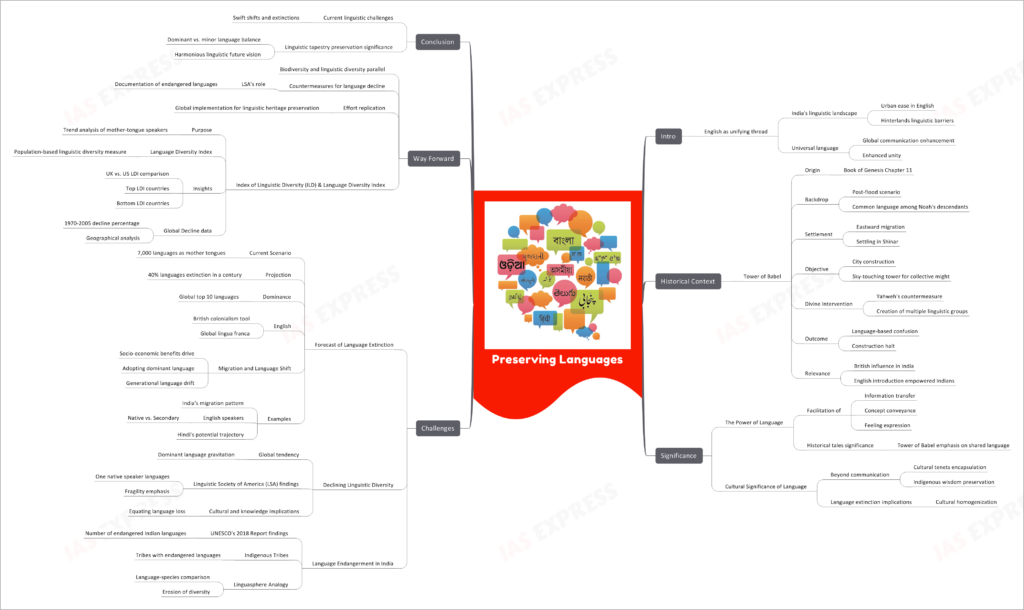Preserving Languages- What can we do about the Declining Linguistic Diversity?
English, tracing its roots to the British Raj in India, has long served as a unifying thread among the diverse linguistic landscape of the country. While urban areas see ease in English communication, the hinterlands face linguistic barriers. This brings forth a contemplative query: wouldn’t a universal language make global communication seamless and enhance unity?

This topic of “Preserving Languages- What can we do about the Declining Linguistic Diversity?” is important from the perspective of the UPSC IAS Examination, which falls under General Studies Portion.
Historical Context: Tower of Babel
- Origin: Chapter 11 of the Book of Genesis.
- Backdrop: Descendants of Noah spoke a common language after the flood.
- Settlement: Migrated eastward, settling in Shinar.
- Objective: Constructing a city and a sky-touching tower to manifest collective might.
- Divine Intervention: To curb human ambition, Yahweh fragmented them into multiple linguistic groups.
- Outcome: Divergent languages caused confusion, halting the construction.
- Relevance: Some believe that the British inadvertently empowered Indians by introducing English, which galvanized the end of colonial rule.
The Power of Language
- Language facilitates transmission of information, concepts, and feelings.
- Historical tales, like the Tower of Babel, underscore the potency of a shared language.
Forecast of Language Extinction
- Current Scenario: Approximately 7,000 unique languages are globally spoken as mother tongues.
- Projection: Mathematical models predict a 40% extinction of languages (with speakers < 35,000) within a century.
- Dominance: Half of the global population speaks one of the top 10 languages.
- English: Promoted during British colonialism, it’s the global lingua franca.
- Migration and Language Shift:
- Migration pressures individuals to adopt the dominant language for socio-economic benefits.
- Subsequent generations progressively lose touch with their ancestral languages.
- Examples:
- India’s increasing migration to English-speaking nations.
- English: 340 million native and 1.2 billion secondary speakers.
- Hindi: 586 million secondary speakers, potential growth?
Index of Linguistic Diversity (ILD) & Language Diversity Index
- Purpose: Quantify trends in mother-tongue speakers over three decades.
- Language Diversity Index: Probabilistic measure of linguistic diversity in a population.
- Insights:
- UK: LDI of 0.139
- US: LDI of 0.353 due to diverse migrants
- Highest LDI: Papua Guinea (0.990), Vanuatu (0.972), Solomon Islands (0.965)
- Lowest LDI: Haiti (0.000), Cuba (0.001), Samoa (0.002)
- Global Decline: 20% from 1970-2005; significant in the Americas, Pacific, and Africa.
Declining Linguistic Diversity
- The world gravitates towards dominant languages, endangering minor ones.
- Linguistic Society of America (LSA) notes languages with just one native speaker, emphasizing their fragile existence.
- Language demise equates to cultural and knowledge loss.
Cultural Significance of Language
- Beyond mere communication, languages encapsulate cultural tenets and indigenous wisdom.
- Language extinction heralds cultural uniformity, eclipsing diversity.
Language Endangerment in India
- UNESCO’s 2018 Report: 42 Indian languages nearing extinction, each spoken by under 10,000 individuals.
- Indigenous Tribes: Most imperiled languages belong to tribal groups.
- Linguasphere Analogy: Languages mirror diverse species. Their loss erodes linguistic, cultural, and intellectual biodiversity.
Way Forward
- Recognize the parallels between biodiversity and linguistic diversity.
- Learn and deploy strategies to counter language decline.
- Institutions like the LSA are documenting endangered languages, creating a reservoir of audiovisual and textual records.
- Replicating such efforts globally can stem the loss of linguistic heritage.
Conclusion
In an era marked by swift linguistic shifts and extinctions, safeguarding the tapestry of global languages is paramount. While the allure of a universal language is tempting, the rich mosaic of global linguistics and the cultural treasures they hold is irreplaceable. A balanced approach, celebrating dominant languages without sidelining minor ones, offers a harmonious linguistic future.
Practice Question for Mains
Analyze the importance of linguistic diversity in the context of globalization. Suggest measures for preserving languages in India. (250 words)

